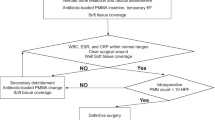Summary
A total of 52 patients with infection after fracture of the proximal tibia were retrospectively reviewed from 1988 to 1995. 26 patients were transfered from peripheral hospitals with active osteitis, while 26 patients had been primarily treated in our hospital. Refering to the total group of patients, infection inducing factors are discussed critically. All patients underwent radical debridement. Restoration of bone stability had to be done in 73 %. Due to the extent of infection, segmental resection had to be perfomed on 3 patients. Resulting soft tissue defects were closed with local flaps in 11 cases. Infection was controlled in 41 patients, but only 7 could be classified as “cured”. Nine patients had amputations after failure of treatment. Despite successful therapy, the functional results are poor. Therefore, avoiding infection, has top priority in post fracture treatment. The correct form of osteosynthesis adapted to the soft tissue lesion can lower infection rates significantly. Soft tissue defects, resulting from open fractures or after primary treatment, have to be closed by gastrocnemius flap transfer within a short time. The management of the soft tissue is at least as important as the reconstruction of the bone in the treatment of fractures of the head of the tibia.
Résumé
Nous avons examiné au total 52 patients présentant avec infection après fracture de l' extrémité proximale du tibia entre 1988 et 1992. 26 patients étaient transférés d'autres hôpitaux avec une ostéite évolutive, 26 patients étaient traités entièrement dans notre hôpital. Nous discutons l'étiologie de l'infection de ces deux groupes.
Tous les patients ont été traités avec débridement radical. Une stabilisation osseuse fut nécessaire dans 73 % de cas. Nous avons réalisé une résection segmentaire à cause d'une large infection dans 3 cas. La perte de substance causée par cette intervention a été fermée par une lambeau local dans 11 cas. Ainsi nous avons pu arrêter l'infection dans 41 cas mais seulement 7 patients peuvent être considérés comme entièrement guéris (13 %). Dans 9 cas l'amputation a due être effectuée. Malgré le succès thérapeutique concernant l'infection elle même, le résultat fonctionnel est resté mauvais. C'est pourquoi éviter l'infection reste le point le plus important traitement d'une fracture. Le pourcentage des infections peut être abaissé en utilisant un type d'osteosynthèse adapté aux besoins des tissus mous. Il faut fermer les pertes de substance initiales d'une fracture ouverte ou causées par le traitement initial par un lambeau de muscle jumeau (musculus gastrocnemius) après un délai de quelques jours. Soigner les tissus mous correctement est au moins aussi important que de reconstruire les fragments osseux, lorsque l'on traite une fracture de l'extrémité proximale du tibia.
Similar content being viewed by others
References
Muggler E, Bartzke G, Burri C (1978) Die Tibiakopffraktur. Problematik, operative Therapie und Resultate. Unfallchirurgie 4: 175
Ruedi T (1976) Operative Behandlung der Tibiakopfbrüche. Unfallheilkunde 126: 248
Holz U, Welte G, Märklin HM, Weller S (1985) Ergebnisse nach operativer Versorgung von Tibiakopffrakturen. Unfallchirurg 88: 519–527
Wagner HE, Jakob RP (1986) Zur Problematik der Plattenosteosynthese bei den bikondylären Tibiakopffrakturen. Unfallchirurg 89: 304–311
Tralles D, Wojczik H, Hildebrandt T (1990) Tibiakopffrakturen — Auswertung einer DDR Sammelstudie 1981–1985. Zentralbl Chir 115: 635–643
Tscherne H, Oestern HJ (1982) Die Klassifizierung des Weichteilschadens bei offenen und geschlossenen Frakturen. Unfallheilkunde 85: 111
Müller ME, Nazarian S, Koch P (1988) The AO Classification of fractures. Springer-Verlag, Berlin Heidelberg New York
Tscherne H, Lobenhöffer P, Russe O, (1984) Proximale intraartikuläre Tibiakopffraktur. Unfallheilkunde 87: 277–289
Müller ME, Allgöwer M, Willenegger H (1993) Manual der Osteosynthese. Springer-Verlag, Berlin Heidelberg New York
Rehn J (1977) Die operative Behandlung der Schienbeinkopfbriiche. Zentralbl Chir 102: 905–911
Sarmiento A, Calta U (1984) Nicht operative funktionelle Frakturbehandlung. Springer-Verlag, Berlin Heidelberg New York
Trapp H (1981) Tibiakopffrakturen-Formen und Ergebnisse nach operativer und konservativer Therapie. Inaug. Diss. Lübeck, Germany
Laughlin RT, Smith KL, Russell RC, Hayes JM (1993) Late functional outcome in patients with tibia fractures covered with free muscle flaps. J Orthop Trauma 7: 123–129
Steinau HU, Germann G (1991) Plastischrekonstruktive Mikrochirurgie zur posttraumatischen Infektionsprophylaxe und -therapie. Chirurg 62: 852–860
Fitzgerald RH, Ruttle PE, Arnold PG, Kelly PJ, Irons GB (1985) Local muscle flaps in the treatment of chronic osteomyelitis. J Bone Joint Surg [Am] 67-A: 175
Mathes SJ, Alpert BS, Chang N (1982) Use of the muscle flap in chronic osteomyelitis. Experimental and clinical correlations. Plast Reconstr Surg 69: 815
Mathes SJ, Alpert BS, Chang N (1983) Coverage of the infected wound. Ann Surg 198: 420
Fleischmann W, Strecker W, Bombelli M, Kinzl L (1993) Vakuumversiegelung zur Behandlung des Weichteilschadens bei offenen Frakturen. Unfallchirurg 96: 488–492
Author information
Authors and Affiliations
Rights and permissions
About this article
Cite this article
Heppert, V., Rheinwalt, K., Winkler, H. et al. Infection of the proximal tibia after fractures — An avoidable complication. Eur J Orthop Surg Traumatol 7, 195–198 (1997). https://doi.org/10.1007/BF00579288
Received:
Accepted:
Issue Date:
DOI: https://doi.org/10.1007/BF00579288




